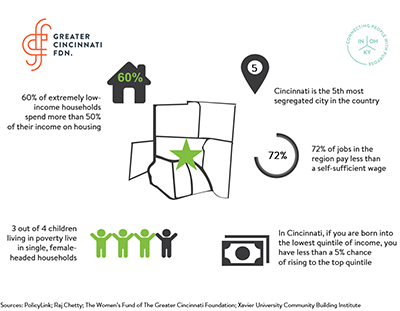GCF’s Strategic Focus on Equitable Communities
Greater Cincinnati has many reasons to cheer, and our civic achievements are numerous and impressive. Alternatively, our region also has systemic barriers that need to be tackled to bring about opportunity for everyone. Building upon the powerful research of the Women’s Fund of Greater Cincinnati Foundation (GCF), we know that investing in women translates to progress for all families.
In addition, GCF recognizes that housing stability and economic mobility — especially among women of color — are two of the most critical pieces of the equity puzzle. Some key statistics of our region:
Housing Stability:
- The affordable housing cost burden is defined as 30 percent or less of one’s income, to allow for resources to cover food, transportation, health care and other needs — let alone emergency savings and long-term investments. At a minimum wage of $8.15, that translates to a monthly rent of $423.80, which is nearly $200 below the Fair Market rate of $613 for a one-bedroom apartment in Greater Cincinnati.
- In our region, 47 percent of all residents have a higher than 30 percent of income housing cost burden; black residents have the highest at 57.9 percent.
- In 2016, there were approximately 16.9 evictions per day in Hamilton County, or 6,039 for the year.
- The black home ownership rate in Hamilton County was 31.94 percent in 2015, compared to a 72.54 percent rate of white home ownership.
Economic Mobility:
- Regionally, 31.34 percent of the black population was living below 100 percent of the poverty level in 2015, compared to 9.43 percent of the white population.
- The child poverty rate is 55 percent for blacks, four times the 13 percent rate of whites.
- Three out of four children living in poverty here live in single, female-headed households.
- The median hourly wage has fallen by $3 per hour since 1980 for both whites and blacks, but the discrepancy has remained essentially the same: $22 an hour versus $17 an hour, respectively. For college-educated workers, the gap is $6 per hour between blacks and whites.
- In our region, 72 percent of jobs pay less than a self-sufficient wage.
With a deep commitment to diversity, equity and inclusion, we invite donors to join us in providing “all-in” pathways to self-sufficiency that benefit and strengthen our shared future.
Greater Cincinnati Foundation (GCF), in partnership with Interact for Health and the United Way of Greater Cincinnati, is committed to transforming our conflicting “tale of two cities” to one uplifting narrative of equity with the All-In Cincinnati Initiative. Constructed on the framework provided by the national research and action institute PolicyLink and guided by a core team of civic leaders, the All-In Cincinnati roadmap will be released this fall.

